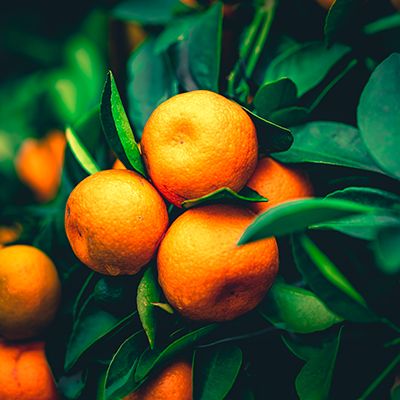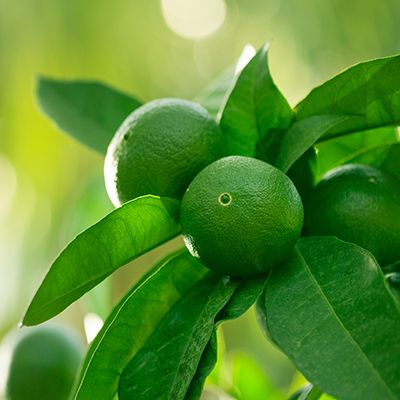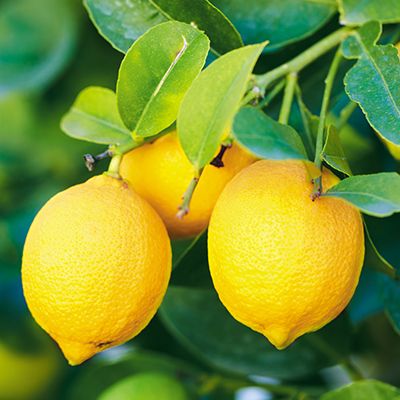


Citrus
General Information: Incorporated into the landscape, citrus trees and shrubs offer year-round attraction with their glossy deep green foliage, fragrant flowers and decorative fruit in season. They require full sun to perform best and may perform even better if you locate them in areas that collect heat and light, such as near stucco walls or in bright corners. They also make excellent container plants if you select appropriately sized containers.
Planting: Since citrus trees prefer well-drained soils, it is important to locate them in fast-draining locations, and to amend the soil when planting. To plant, dig a hole at least 2 times the diameter and the exact depth of the nursery container (See also our Care Guide on Planting Trees and Shrubs). Amend the native soil with one-third Gold Rush or Bumper Crop. Add Master Nursery Master Start to the bottom of the hole and mix in well. Remove the plant from its container and place in the hole with the graft facing North or East (so it is not hit by the hot sun). The next step is to backfill with remaining soil mixture, ensuring that the graft union remains 4-6 inches above the soil line. To facilitate watering: build an irrigation berm 4-6 inches high and about one foot beyond the drip line with the remaining soil mixture. To prevent water from sitting against the trunk, slope the soil away from the trunk of the tree and toward the berm. Remember that the berm will need to be extended as the tree matures. After the tree is planted, paint the trunk up past the lowest limbs with interior white latex paint diluted 50% with water. Do not plant within four feet of any concrete foundation as lime leaches from the concrete and produces an alkaline soil. There should be no plants (grass, shrubs, annuals, etc.) within the drip line of the tree. Mulching within the dripline is advisable, but not closer than 2 inches from the trunk.
Watering: During the peak of summer heat, newly planted trees should be watered approximately twice a week, and established trees should be watered every other week. To water, fill the basin completely and add water until it stops bubbling. For mature trees, this may necessitate leaving the hose on for several hours. During fruit production, consistent watering (e.g. 1 time per week or once every two weeks, etc.) will reduce the chances of the skin splitting as the fruit develops. Damage from over-watering is greatest in clay soils. Since soil conditions vary, space watering intervals so that the top 4-6 inches of the soil dries between irrigations. Do not let lawn sprinklers water the trunks of citrus trees. Consider the amount of water irrigating the tree from the lawn sprinklers to be zero. If the tree is planted in clay soil, start irrigation in mid-May.
Fertilizing: Master Nursery Citrus Food or Gardner & Bloome Citrus & Fruit Tree Fertilizer is specially formulated for citrus, containing the macronutrients (nitrogen, phosphorous and potassium) along with key micronutrients such as iron, sulfur and calcium. If foliage is chlorotic (yellow-green) supplement with Iron Sulfate about Valentine’s Day. In October, mulch trees with GreenAll Chicken Manure, which will provide nitrogen, insulate the roots during winter, and increase soil friability as it breaks down. Apply the fertilizer from about one foot away from the trunk to just beyond the drip line. Water thoroughly after spreading the chicken manure.
The following is a general guide for fertilizing your citrus. Apply fertilizer at 2 month intervals from mid-March through September. Use the following amounts:
| Diameter of Tree in Inches 24” above Soil | Cups of Fertilizer per 2 Months |
| 1/2” | 1/2 cup |
| 1” | 1 cup |
| 2” | 2 cups |
| 3” | 2-1/2 cups |
| 4” | 3 cups |
| 5” | 4 cups |
Pruning: All citrus trees have been budded or grafted on an understock. Standard trees can reach 20-30 feet tall and wide, and dwarf trees can reach 5-12 feet tall and wide. Citrus plants bloom and produce fruit on new growth. On young trees, tip-pruning will strengthen the branches, so that the weight of mature fruit is less likely to cause damage. Lightly thinning the interior of the tree will help light to enter and increase air circulation, which will also help minimize insect problems. Citrus can also be pruned to keep it to size. Check trees periodically for suckers (branches that arise below the graft line) and remove them before they compete with or overwhelm the desired variety. Remove water sprouts; the thick, vigorous, thorny shoots that grow from within the crown. Prune trees for shaping in spring or early summer so that new growth matures before the onset of cold weather.
Hardiness: While various citrus trees differ in temperature hardiness, most will be susceptible to damage during heavy frosts. A mature tree’s fruit production may be compromised for a year or so, but the tree will generally rebound given proper general care. Precautions to protect citrus during winter include covering trees with burlap, or a 50/50 sheet of a breathable plastic material such as Easy Gardener’s Plant Protecting Blanket or N-Sulate. Be sure to cover the protecting material above the tree’s foliage in order to avoid frost damage to plant parts that may touch it. Cloud Cover is effective to about 28°F or 29°F, so citrus will need additional protection if temperatures dip below 28°F or 29°F. If a severe frost is predicted, a 100 watt lamp (designed for outdoor use) placed in the interior of the small tree under the blanket, will emit enough heat to reduce frost damage. Frost Covers should be removed during daylight hours.
| Sensitivity Levels | ||
| High | Moderate | Low |
| Lemons | Pumello | Kumquat |
| Limes | Grapefruit | Mandarin Orange |
| Navel Orange | ||
| Valencia Oranges | ||
Insect Problems: The most common insect pest of citrus is scale, which clusters on fruit stems and wood, new growth and/or the undersides of leaves. Note that several types of scale may infest citrus. Ants traveling up and down the stem of a citrus plant indicate the presence of scale or other sucking insects such as aphids or mealy bugs. Ants will also herd these insects, milk them for honeydew and interfere with predation by natural predators. If insect problems occur, use Master Nursery Pest Fighter Year-Round Spray Oil or Malathion. They are safe to use all year, but oil should not be used more than 4 to 5 times during a 12 month period. Do not spray with oil if your tree is in full bloom or if temperatures are above 85°F or below 40°F. Doing so may damage the blossoms or leaves and hinder fruit production. If you experience snail or slug problems, band trees with copper strips or spread Sluggo or Deadline under your tree. Be advised though that Deadline contains Metaldehyde which is toxic to all animals.
The Citrus Leaf Miners, (Phyllocnistis citrilla) has become common in the Bay Area. The larvae, (maggot) feeds on the soft growth between the upper and lower layers of leaves on new growth. As it feeds, it leaves a tunnel (Mine) filled with fecal material, visible when the leaf is held up to strong light. This feeding may cause the leaf to curl and fall off. Only very young trees may experience a reduction in growth. Mature leaves are too tough for the leaf miner to penetrate.
Cutting off the infected leaves and biweekly spraying with Spinosad is beneficial on small trees. The University of California recommends leaving the affected leaves alone and letting the natural enemies of leaf miners feed on and parasitize the maggots inside the mines. Most insecticides are not effective and leave residues which kill natural enemies.
Citrus in Containers: Many citrus plants will grow and produce fruit in containers. The container should be about the size of half a wine barrel. Fill the container with Master Nursery Gardener’s Gold Potting Soil. Water whenever the top 3 to 4 inches of soil is dry and until water runs out the bottom of the container. Fertilize MONTHLY from Valentine’s Day until Halloween with Master Nursery Citrus Food or Gardner & Bloome Citrus & Fruit Tree Fertilizer. Measure the diameter of the container in inches and divide that number by six. Use that many level tablespoons of fertilizer for that container (e.g. 18”diameter divided by 6 equal 3 tbs). Suitable plants would be Meyer Lemon, Bearss Lime, Dwarf Mandarin oranges or a Kumquat. Lemons and Limes can be picked any time the color pleases you. Oranges and others should be kept on the tree until 2 or 3 fruits have fallen.
Urban Legends Defused: If your citrus tree does not produce sweet fruit, there is no additive (zinc, magnesium, coffee grounds, chicken manure, etc.) which can be used to sweeten the fruit. Sweetness of citrus fruit is a function of genetics and summer heat. We, in the Bay Area, are in a border-line area for growing citrus. Basically, sweetness is a function of summer heat. Cool summers result in acid (sour) fruit while hot summers produce sweet fruit. Leave fruit on the tree until it starts to fall off.